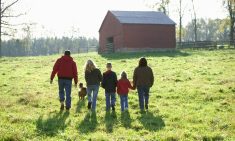Not only are our farms getting bigger and more complex, but farm families are also getting smaller as farming couples have fewer kids, just like other Canadians.

It’s a demographic combination that has changed the ag labour dynamic, says Leah Knibbs. For many farmers, the days of running the farm by putting the family to work or by hiring the kid down the road are gone.
Knibbs would know. She owns a human resources consulting firm (Kn/a HR Consulting), and is a partner in a recruiting firm (Kn/a Sourcing People), so she hears about labour issues from the people most directly impacted — the farmers.
She started her human resources practice while living on the farm in Saskatchewan, and she may be the only HR consultant who has raised pigs and meat rabbits.
After 25 years, she moved from the farm into Weyburn where her company has agribusiness clients, including primary producers.
Read Also

What to consider when setting up farm-related business ventures
Things to consider before launching a farm-adjacent side business.
With fewer available farm kids, farmers are finding themselves more often pulling in employees from other industries, Knibbs says. And that can be where the challenge starts, partly because those employees may not understand agriculture, and also because the employees expect a certain level of HR sophistication from their employers.
- Read more: Three red flags to watch for on your farm
New employees who don’t have a farm background may not realize how long the hours can be, or how physically hard the work is, says Tracy Biernacki-Dusza, a project manager with the Canadian Agricultural Human Resource Council (CAHRC). There can be a disparity between what employees and employers expect, she adds.
To succeed in that new environment, will you have to brush up your own HR skills? Or could it be time to actually hire someone to manage your HR for you?
The evolution of HR on the farm
People tell Biernacki-Dusza that they’re farmers, so you can’t call what they do “HR.”
“Well,” she responds, “Have you hired someone? Are you paying them?” If you answer yes, she says, HR is part of your job description. It’s something you’re accountable for, and it’s something that, for the sake of the farm, you need to do well.
Knibbs compares it to the way accounting has evolved as the nature of farming has changed.
“Accounting used to look like taking a shoebox of receipts to the accountant,” says Knibbs. Then farm journals came in, followed by more complex record-keeping and analysis, so today’s farmers have more sophisticated systems.
The thing is, while farmers may never have enjoyed doing book work, they went through this accounting revolution because they began to understand the benefits that it produced. And the more they followed what their accountants were talking about, the more they were motivated to make accounting a core — and enjoyable — part of their farm management.
Now, the same thing is happening with HR on the farm.
But is your farm still at the shoebox stage of HR practice? And if it is, what’s the best way to begin your own evolution?
The first step is to recognize that major transformations are underway as farmers look for better ways to lead their people.
Over the last year, for instance, Biernacki-Dusza oversaw the creation of National Occupational Standards for 11 commodities, including beef and crop production. Those standards include job descriptions that also define the skills and knowledge an employee needs for the job.
Biernacki-Dusza and her colleagues outlined four roles within each of those commodities — entry level, experienced level, supervisor, and manager.
Unlike other industries, where most workers have defined roles, a farm employee may just be expected to show up and to fit in, doing the jobs that they get assigned.
After all, that’s what farmers do too. On any given day, most farmers do a combination of jobs that range in skill level from labourer to senior manager, Biernacki-Dusza says. “I think that’s such a unique thing.”
However, while that kind of flexibility can seem a plus to the farmer, it can leave the employee uncertain about what’s expected of them.
That doesn’t mean the approach is wrong. It just makes it more important that the farmer and the employee get on the same page, especially because the non-farm employee may not really have any experience operating outside of very clear roles and expectations.
So while a farmer might wonder why anyone would bother defining all those roles in the first place, a lot of it is about outlining the expectations and tasks of an entry-level employee when the farmer hires help.
On the farm, Biernacki-Dusza explains, information tends to be passed along verbally, making it easy to miss something.
You’re still the boss
Having employees means you need to be able to talk to them about your expectations. You also need to manage and measure their performance, and you need to be able to do that while taking on all the other tasks that come with being a manager.
And that can actually be more difficult in a farm context, partly because there can be an unwritten tendency for the employee to almost become part of the family, says Knibbs.
“I think those relationships are wonderful when there is that camaraderie,” she says. “But I’ve seen that camaraderie get in the way of good business.”
Biernacki-Dusza agrees farmers need to have some formality in the employer-employee relationship. “It’s to protect yourself, and to protect the employee.” Writing everything down helps avoid surprises, since everyone knows what to expect if there’s a disagreement, she says.
And it’s not just the non-family employees who can benefit from good leadership in the HR department, although farmers do need to keep in mind that if family members are treated differently than other employees, those employees might perceive unfairness, Biernacki-Dusza says.
It’s an extra reason for having actual job descriptions. Besides, our experts agree, those descriptions will also make it easier to navigate your way through succession. Job descriptions will make it easier to transfer certain tasks to the next generation, so they can have some autonomy and not have Dad looking over their shoulder all the time.
As well, descriptions can make it easier to assign a son or daughter to supervise an employee (or employees). With a description, everyone can be clear on how the job will be assessed at the end of the day, and it will be easier to mentor the son or daughter on their leadership skills.
Do it yourself or contract it out?
When Knibbs went into business, one of the best pieces of advice she got was, “Know what you do well, and buy the rest.”
This advice probably rings true for many farmers too, who are no strangers to contracting services from agronomists, custom harvesters and accountants. Taking on more land feeds into this need as well.
“Time pressures tend to help you sort out your priorities,” Knibbs says. Farmers need to decide what they do well because that’s where they can be effective and make their money.
Whether that should include people management is partly a personal choice, Knibbs says. A lot of it comes down to whether the farmer likes doing it, and how it fits into the overall business plan.
Some farmers can justify hiring a foreman, or contracting an HR firm to help with bigger questions such as how to hire and keep employees. But the day-to-day stuff is still going to be in their hands, Knibbs says.
“If you are going to have employees, you can never run away from being a supervisor,” she says. As the farm grows, someone will need to be able to manage people. Usually, farm families figure out who has the best head for it, she says, which is a good approach.
“I think you have to look at the people in your family, each individually, because everybody has certain skills,” says Biernacki-Dusza. Farm families should consider what each person has been exposed to within the family business. Doing this helps foster discussion around succession planning, and identifies what skills are needed, Biernacki-Dusza adds.
Knibbs says there’s no magic test to measure a person’s HR skills. But there are all kinds of self-analysis tools to figure out what kind of leader you are, she says.
To Knibbs, asking questions is the key to evaluating one’s HR potential. “How good am I at leading and managing my people?”
Next, Knibbs says, it’s a matter of figuring out whether expectations of employees are clear, whether the farmer is following laws and regulations, and how the farm’s recent hires have turned out. Knibbs compares it to asking questions about a crop rotation. How did the barley perform when it followed the lentils?
Biernacki-Dusza suggests farmers read through CAHRC’s Agri HR Toolkit, an online resource to help farmers manage people. If a farmer wonders if they need help hiring employees after reading through the recruitment and retention section, she says, they probably do.
On the farm
Working with an HR expert can help as well, Knibbs says. For example, hiring a pro to develop an employee manual means it will likely include good practices and be current, and that the farmer will learn from the process too.
Creative farmers could also create their own HR support groups, similar to other peer groups focused on things like benchmarking costs. The group could invite speakers, Knibbs says.
CAHRC is also developing resources to help farmers train employees. Right now they’re working on an e-learning pilot for broiler breeders. The online courses will cover the reasons behind practices such as foot baths and washing eggs, Biernacki-Dusza says. The aim is to give employees the why, then allow the producer to show employees how to do it on the farm, she adds.
Knibbs is confident farmers can up their HR game. They’re smart people, she says. Plus they’ve done it in other areas already.
Says Knibbs: “If they looked at HR in the same way that they looked at building their capacity in other areas, it would be much easier.”
Getting help
The good news for farmers is that there are resources to help them become better managers.
For instance, Tracy Biernacki-Dusza, project manager with the Canadian Agricultural Human Resource Council (CAHRC), says her organization is revamping its website and the AgriSkills HR Toolkit so they’re in plain English to make it easier for farmers unfamiliar with human resources jargon.
The revised tool kit will help farmers identify and manage their HR problems. The tool kit can be obtained by clicking on the tool kit tab at the council’s website at cahrc-ccrha.ca.
National job board
The council has also created a national agriculture job board at retail.agrijobmatch.ca. Farmers can pull in and customize the job descriptions that CAHRC recently completed, and they can also post job ads.
As well, the site provides an interview guide, and once employees have been hired, the site’s job descriptions can help farmers design training for a new employee.
Meanwhile, Knibbs and her colleagues are developing an HR boot camp that will include four modules. “It’s not going to make you an HR expert, but you’re going to be at least aware and have some of the basic skills.
















